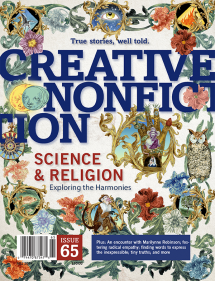February 06, 2018
What exactly is Creative Nonfiction?
 People are always asking: “What exactly is creative nonfiction?”
People are always asking: “What exactly is creative nonfiction?”
The short answer, which appears on the banner of my magazine, Creative Nonfiction, is “True Stories Well Told.”
But here’s a longer answer:
Essentially, the mission of creative nonfiction is to communicate ideas and information in a cinematic way using the literary techniques employed by fiction writers—dialogue, description, detail, action, scenes, to introduce the characters behind the facts with action and excitement in a more compelling story-oriented way than with straight exposition or traditional journalism.
But unlike fiction, the story is true, the characters real, the facts accurate. “Creative” doesn’t mean inventing what didn’t happen, reporting and describing what wasn’t there. It doesn’t mean that the writer has a license to lie. The cardinal rule is clear: You can’t make this stuff up! – the title of the most recent book I have written about the genre.
Those movies we see that are BOTS—based on a true story, like Hidden Figures, Sully, Selma, Fruitville Station, even All the President’s Men—are in many ways elaborated for dramatic effect and often with made-up characters and events—and therefore as much fiction—or maybe moreso – as fact. Or, as some people might say, “faction.” The reader doesn’t know what to believe and what to chock up to a writer’s or director’s imagination. BOTS entertain and sometimes inform, but also can invariably mislead.
Writing true stories, creative nonfiction, is very much a balancing act, weighing and synchronizing the style and substance. Too much style—the creative part—provides a reader with a good story, perhaps, which is essential. But it decreases the opportunity for a reader to learn from the writer and to gain information and insight. While it is true that everyone appreciates a good true story, readers need to know, sooner rather than later, why they are taking the time to read the story, how will they benefit from the story and the characters, ideas, events or situations the writer is introducing. That’s the substance part.
Writing true stories, creative nonfiction, is very much a balancing act, weighing and synchronizing the style and substance.
Too much information, on the other hand, can be tedious, boring and subsequently off-putting. If a reader is not interested in baseball or quantum physics or incest, or whatever, they will turn the page of the magazine they are leafing through or buy a different and more appealing book. It is easy enough to attract a reader who is interested in the subject you are writing about—that’s your base audience. You are, as they say, preaching to the choir. But if you want to expand your readership, connect with people with information and ideas they might have never considered before, motivate and enlighten them, then the balance between style and substance is key.